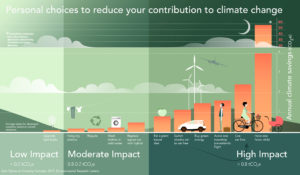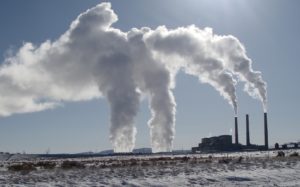Recently I asked some authorities on climate change: “what is the most effective way of decreasing greenhouse gas emissions?†They gave stock answers about decreasing consumption. “If you were my students, your grades would all be D’s†was my response.
They are, unfortunately, not alone. A recent study listed the 4 most effective activities that people can do to decrease their emissions. Three of them are what you might expect, while the most effective one—by far—might be unexpected.
The measure used by the authors of this article is tonnes CO2-equivalent (tCO2e) emission reductions per year. The average person in the USA causes about 16 tonnes of CO2 to be released annually. (a tonne is a metric ton; roughly equal to our ton of 2000 pounds) Here are the 4, listed from least to most effective.
Eat a plant-based diet. This has health benefits as well as aiding the environment. It is clear that eating meat, especially red meat, is bad for your health. The effects on the world around us are also negative—excessive use of water, sewage lagoons that pollute ground water and dead zones in the ocean from animal waste. An individual’s annual saving by avoiding meat is almost a tonne.
Our transportation system depends on fossil fuels, which generate CO2 when used. It makes sense that avoiding air travel and not driving a car would decrease carbon emissions. Giving up both air travel and your car would keep 4 tonnes of CO2 out of the atmosphere.
Buying “green†electricity is quite effective, and is inexpensive—thanks to our electrical cooperative. Switching from power produced with coal to renewable sources prevents 1.5 tonnes of greenhouse gas emissions—and makes our air healthier.
The most effective thing that an individual can do to reduce his or her carbon footprint is to have one fewer child. The effect is strong because of the “carbon legacy†of a child born in a rich country. The carbon footprint of the individual child is significant, but the legacy of all that person’s progeny (who will go on for many generations) is huge. A child not conceived reduces a person’s carbon footprint by 58 tonnes! Yes, the one best action an individual can take to reduce his or her carbon footprint is to choose to have a small family—or no children at all.
Unfortunately, most people who study, write and teach about greenhouse gas reduction don’t consider the impact of childbearing. The authors of the paper mentioned above also studied governmental recommendations to reduce emissions from the EU, the USA, Australia and Canada. Not surprising, they found that the recommendations all focused on less effective actions.
Likewise, the paper examined the content of science textbooks. They searched several textbooks used in Canada for suggestions to reduce greenhouse gas emissions. Very few of the recommendations were for the 4 most effective actions named above.
To quote from this paper: “It is especially important that adolescents are prepared for this shift [to reduce carbon emissions]. They still have the freedom to make large behavioural choices that will structure the rest of their lives, and must grow up accustomed to a lifestyle that approaches the 2.1 tonnes per person annual emissions budget necessary by 2050 to meet the 2 ° C climate target.†They went on to write: “Furthermore, adolescents can act as a catalyst to change their household’s behaviour.â€
They also compared less effective and highly effective interventions: “…a US family who chooses to have one fewer child would provide the same level of emissions reductions as 684 teenagers who choose to adopt comprehensive recycling for the rest of their lives.†The paper concludes: “Some high-impact actions may be politically unpopular, but this does not justify a focus on moderate or low-impact actions at the expense of high-impact actions.
I hope that the importance of childbearing gets across at the Climate Change Symposium to be held Thursday afternoon, November 9th. This Symposium will be a new venture for Fort Lewis College Lifelong Learning programs. It will feature 5 outstanding experts speaking on a topic of major importance. The keynote speaker is internationally known scientist Kevin Ternberth.
The Symposium is now history for most people reading this. I hope that the importance of population growth has been driven home by the article by Seth Wynes and Kimberly A Nicholas that I used as the basis for this column. It is “The climate mitigation gap: education and government recommendations miss the most effective individual actions” and can be found at:Â https://doi.org/10.1088/1748-9326/aa7541
© Richard Grossman MD, 2017

